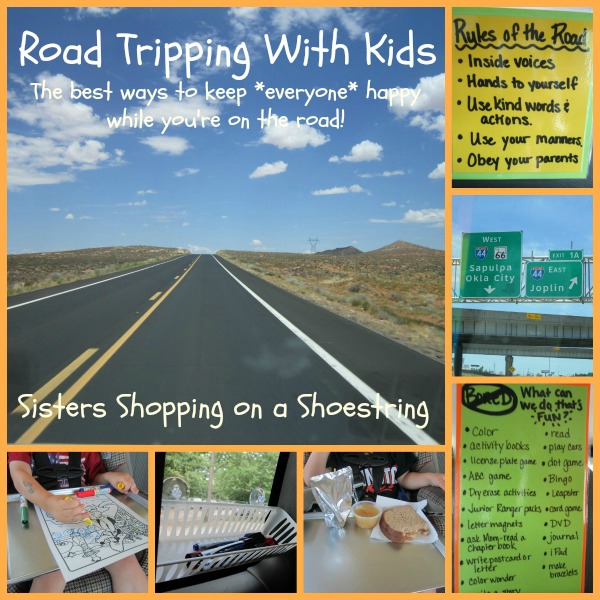Hitting the road with kids this Spring Break? Here’s your survival guide! If you missed Part 1 of the series yesterday, check out Tips for Road Tripping with Kids
Today I’ll share a little about how I help set my kids up for success with their behavior while we travel long distances. Your needs in this area might vary depending on the age of your kids and how long you’ll be driving. Since we spent quite a few long days in the van this summer, I knew we needed a game plan. Bad behavior in the car not only drives the rest of the passengers nuts, it can be downright unsafe because it distracts the driver.
If you’re covering a lot of miles with your kids, set aside a little time before you leave to lay down some groundwork. Then be consistent with follow-through, both with rewards and consequences, as you travel. It won’t guarantee a perfect trip, but it can help give the whole family the best possible chance at peaceful road tripping.
Before you go:
- Set expectations: Create a list of “Rules of the Road” with your kids. Ask for their input, and discuss why each rule is important. For instance “Using inside voices” is important because the driver needs to be able to focus on the road without distractions from screaming children to keep us all safe (and because screaming annoys everyone else in the car! 😉 )
- Everyone’s part of the team: Make sure the kids understand that in order to do something special (our vacation), we need to work as a team to make that happen. The driver’s job is to drive safely and get us to the destination; the other adult (if applicable) is there to help navigate, help the kids, etc.; and the kids’ job is to behave in the car so that the driver can focus and everyone can enjoy our trip. If the whole team does their jobs, we’ll get to our destination safe and happy!
- Gather some simple rewards: Cheapie dollar store activity booklets, small toys, a cheap DVD or two for long trips…stock up in the weeks leading up to your trips when you see great deals. A $10 investment in rewards (giving the kids something to work toward) can be priceless if it allows you many hours of peaceful travel!
- Create a behavior system to use as you drive: We borrowed the idea of a color-coded behavior clip system from my son’s Kindergarten teacher. When they do something particularly kind or helpful, they can “clip up,” and if they forget one of the road trip rules, they “clip down.” They work as a team to earn stickers toward rewards when they clip up to the highest level (10 stickers between the 4 of them means they get a small reward). Clipping down to the lowest level means a loss of screen time, which is enough of a threat that I’ve really never had to enforce it. Since time outs don’t really work on the road, it’s helpful to have some way to give a consequence if necessary, and I like how this method rewards good behavior as well!
On the road:
- Reinforce expectations and set consequences: We review the rules in the driveway before leaving, and I also reinforce them by thanking them for following a specific rule when they clip up. Since they’re all working together toward the goal, we’ve found that they help remind each other about behavior rather than my husband or I intervening—win-win! If someone isn’t following a rule, I give them a chance to pull themselves together, and if they don’t they clip down. I try to use those opportunities to remind them why the rule is important, and why they need to follow it.
- Be involved: Tune in, talk to the kids, read to them, sing with them, play with them, and interact as much as possible. It’s not necessarily “relaxing,” but it’s much less stressful than listening to whining and screaming!
- Keep things positive: The more I can “catch the kids being good” on long trips, the better the mood of the whole van. When I can thank them for being good and doing their part, then let them clip up, they really seem to soak it up and behave better overall. It also helps to give some weight to the times when I need to correct behavior, because I haven’t been nagging them the whole trip.
- Read the signs: If it looks like behavior is starting to go downhill, it might be a good time to switch up activities, have a snack, or stop for a stretch & run around break. Shifting gears can help.
A long trip with kids will never be perfect, but hopefully some of these tips will help make it as peaceful and painless as possible. Do you have any extra tips to share about helping your kids with behavior on long road trips? We’d love to hear them in the comments! Check back tomorrow for another post in the series, Road Trip Fun for Kids.




